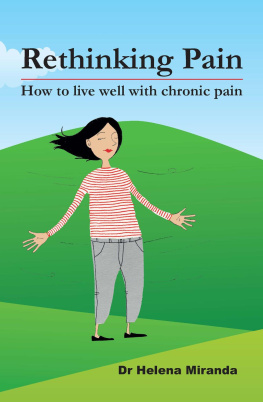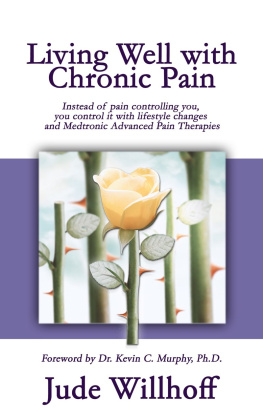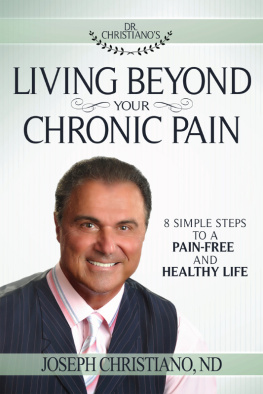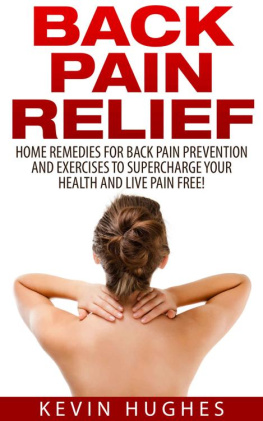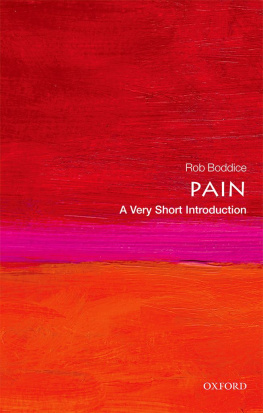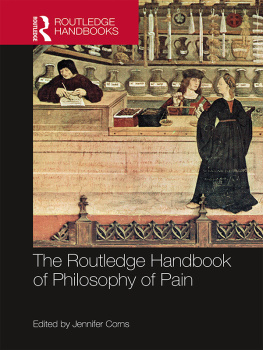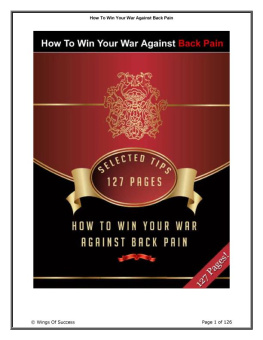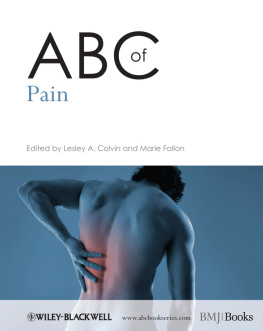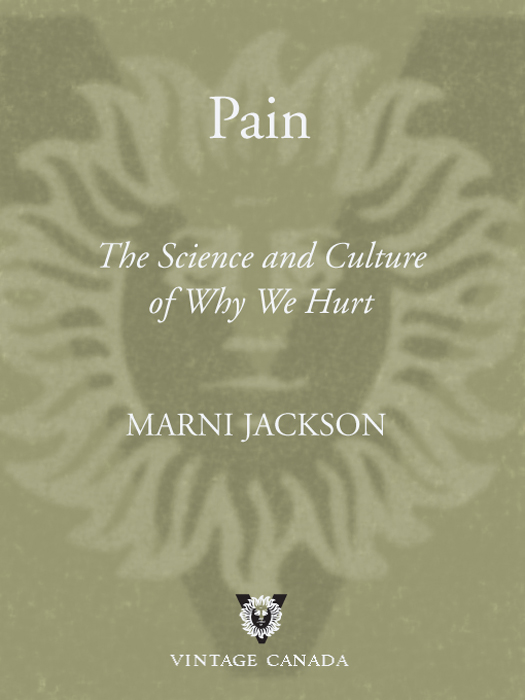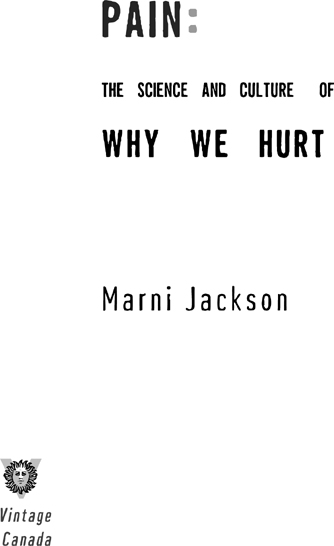ACKNOWLEDGMENTS
I began this expedition with one or two intuitions that I hoped to test as I went about educating myself about pain. All I had to do was acquire a working knowledge of physiology, neurology, psychology, philosophy, pharmacotherapy, Chinese medicine, molecular biology, and acupuncture while browsing through the canon of Western literature. In practice, what this has meant is that I have depended on the expertise and generosity of many experts and authors who have devoted their lives to such matters.
For their patience in dealing with a civilian, I would like to thank the following scientists, physicians, dentists, clinicians, and therapists: Frank Adams, Angela Mailis, V. S. Ramachandran, Harold Merskey, Allan Basbaum, Joel Katz, John Dostroevsky, Karen Davis, Paul Kelly, Simon Vulfsons, Sydney Brenner, Patrick Wall, Kathleen Foley, Nikolai Bogduk, Chris Wells, Chris Mains, Maureen Dwight, Laura Dempster, Marion Harris, Rosa Spricer, Xiaolan Zhoa, Miriam Erlichman, Paula Nieustratten, Robin Conway, John Loeser, Mike Salter, Jeff Mogil, Ron Melzack, Wendy Simmons, Gordon Waddell, Mark Sullivan, Ned Block, Ellen Thompson, Patricia McGrath, Allen Finley, and the members of the Comprehensive Pain Program unit at the Toronto Hospital.
Two books in particular persuaded me that this was indeed a rich subject and not a chimera: The first was The Body in Pain: The Making and Unmaking of the World, by Elaine Scarry, a work that eloquently addresses the silence surrounding this subject. The second was The Culture of Pain, by David B. Morris, a book that I was too apprehensive to open for the first two years of my research. I am glad I waited. It is a work of stunning scholarship, both broad and deep, written with unusual grace. If I had encountered it earlier, it might have convinced me that I had nothing to add on the subject. As it turns out, although our paths are convergent, our missions are quite distinct. But The Culture of Pain set the ropes on this route almost ten years ago.
Two institutions have been indispensable to my education: the International Association for the Study of Pain, and the Louise M. Darling Biomedical Library at UCLA in Los Angeles, home of the John C. Liebeskind History of Pain Collection. The IASP has done a tremendous job of promoting pain awareness and research, and I have relied on their newsletters, publications, and conferences to gain some grounding in the science of pain. President Barry Sessle was especially helpful in steering me to individuals. I am also indebted to Kathleen Donahue, archivist Russell Johnson, the late John C. Liebeskind, and medical historian Marcia Meldrum for their help and guidance during my visit to the History of Pain Collection. The portraits of Silas Weir Mitchell, William Livingston, and Cicely Saunders included here are based on extensive interviews conducted by John Liebeskind and Marcia Meldrum, as well as personal papers in the archives. I have relied on research collected by Martin Booth and Barbara Hodgson in their respective books on opium in the chapter Smoke and Pills.
I didnt have to look far for pain stories: they are everywhere. Invisible courage surrounds us. I owe respect and thanks to the following for sharing this most private experience: Lori Biduke, David and Anna Kelly, Teresa Stephens, Debbie Dyja, Eileen Whitfield, Sandy Kybartis, Barry Arsenault, Heather, Zoe Yanovsky, Ramiro Puerta, Carole Corbeil and Layne Coleman, Jori Morrison, Olive and Clyde Jackson, Alice van Wart, Reverend Ken Martin, and Cathleen Hoskins. Thanks as well to Chuck G. for helpful hints from the Torture Garden, and to Bob Dylan and Leonard Cohen for all their fieldwork.
Pain moves around, and so did I. For their generosity in offering writing refuges, I thank Jill Frayne, Barbara Gowdy, Sue Swan, Anne Nicholson and Arne Moore, and Doug Bell. In particular, Jills house set my compass in the right direction. I made liberal use of their bookshelves as well.
If pain is solitary, I made sure that writing about it wasnt. Many thanks to the following friends for their support, advice, and timely edits: Anne Mackenzie, Beret Borsos, Barbara Gowdy, Judith Timson, Jane OHara, Ian Brown, Jill Frayne, and Brian Johnson.
Thanks to Kirsten Hansen for her helpful manuscript suggestions. A version of the chapter on Dr. Angela Mailis appeared in Toronto Life magazine, with the invaluable editing of Angie Gardos. A portion of my interview with Dr. Paul Kelly appeared in Macleans magazine. In the matter of the great title debate, special thanks to Michael Ondaatje and Linda Spalding, David Reed, Robert Ramsey and Jean Marmoreo, Anne Mackenzie and Zalman Yanovsky (Mein Kramp) for their thoughts. Naming pain isnt easy.
My interest in the intertidal zones of science and art is a direct result of conversations around the dinner table, with my quasi-medical, scientifically adventurous family. My mother and father, Olive and Clyde Jackson, remain terribly curious, about everything. My brother Bruce, an early pain initiate, and his wife, Kathy, helped me with the biochemistry of it all. I have also learned much about graceful strength from my sister Jori, and Lola Johnson.
Once again, my editor and publisher, Anne Collins, imagined that I could do this, and gamely waded through the swamps and bogs with me. No Anne, no book. Her rare combination of intelligence, integrity, and giddiness is something I continue to cherish. I was also aided and calmed by Pam Robertson at Random House. My agent, Anne McDermid, never once blanched at the idea of selling a lovely book about pain; I thank her and Ann Patty for their early enthusiasm for the project. To Doug Pepper at Crown I offer thanks for editorial steadiness during a shaky time in New York. I am grateful as well for the care and engagement of production editor Pam Stinson-Bell.
Now, do you know what it is like to be married to or mothered by someone who is writing a book about the nature of pain? For years? Who wants to talk about shingles or stump pain over dinner? Luckily, I had two discerning writers under the same roof who understood this chronic statemy husband, Brian Johnson, and my son, Casey. I leaned on their good judgment and support. Not only were they patient through the troughs of gloom that come with such enterprises, but they stayed interested. Amazing. Above all, my love and gratitude to Brian for never letting me lose sight of the pleasure principle.
Contents
33
INTRODUCTION: THE STING
I was riding a bike in the Rockies, near Banff, Alberta, when a bee flew into my mouth. At first I thought Id been hit by a flying cork (as if champagne bottles are always popping off in the woods). Then I felt a slim, unambiguous lance of pain, like a splinter of glass. The feeling of the sting crystallized everything about the morning so farmy impatience to catch up to the others, the chill of the mountain air on my arms, a small worry about having taken the wrong road.
My husband and son eventually noticed my absence and circled back. We stood around waiting to see if I would topple over, a not unheard-of event on our family vacations. Ive had little dying spells before, anaphylactic reactions to this or that, although never to bee venom. But as a well-read hypochondriac, I knew that a sting at the back of the throat can cause the airway to swell up and close. A bee could, in other words, lead me to literally strangle myself on this flat stretch of pavement or so my thoughts ran. (Pain experts have a word for this:


